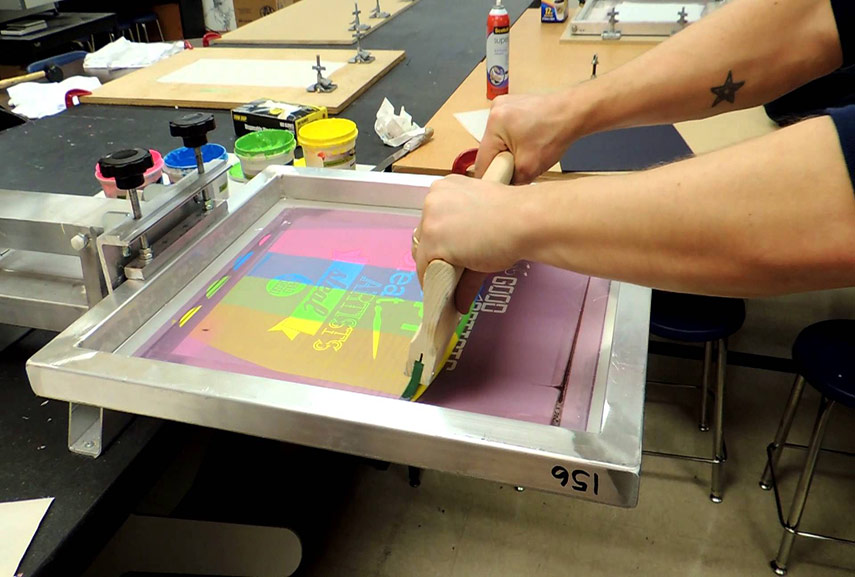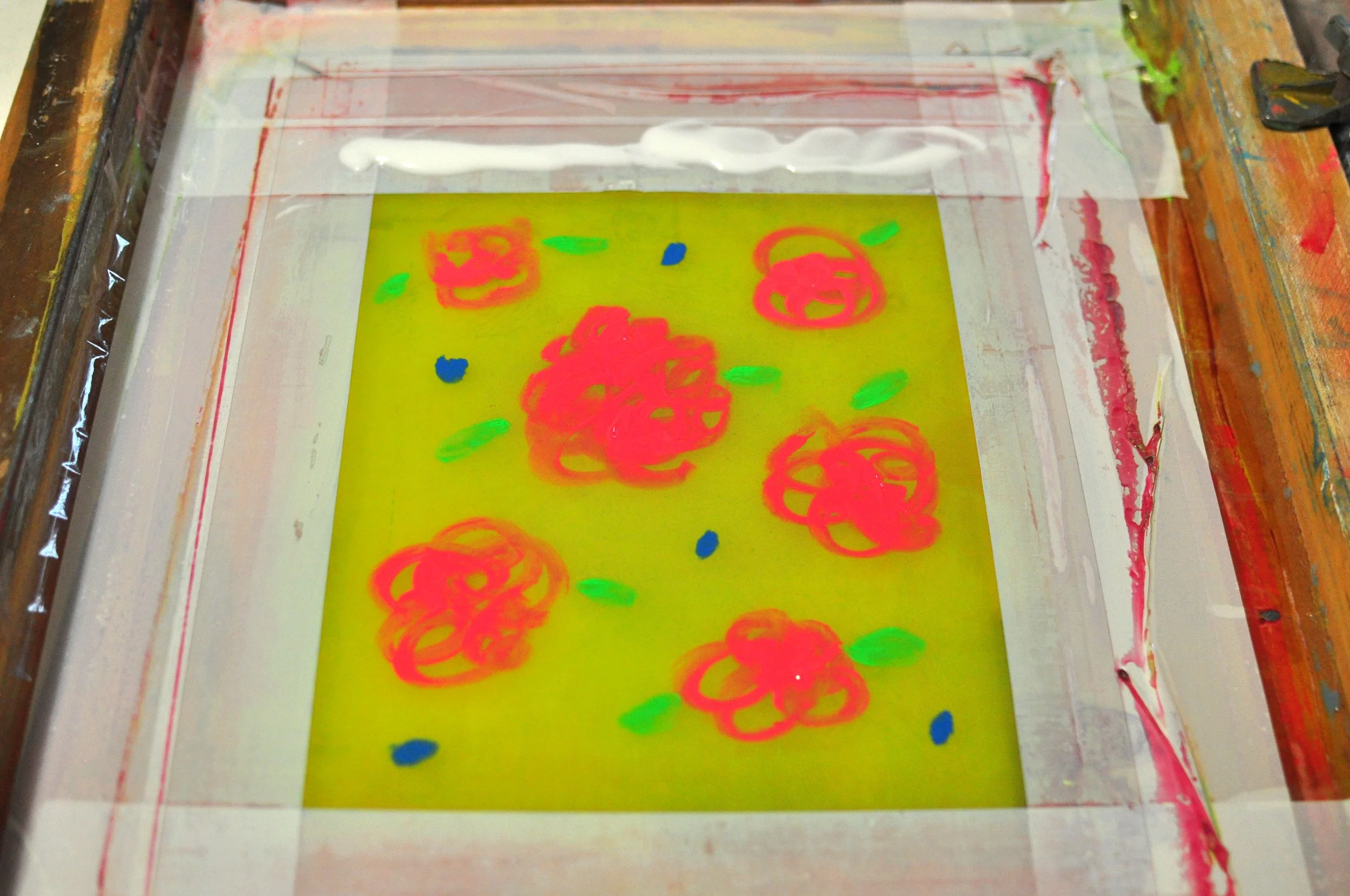Discover the Various Kinds Of Screen Printing Techniques for Your Next Job
Screen printing uses a diverse variety of strategies that can enhance any imaginative task. From traditional approaches like serigraphy to modern-day developments such as direct-to-garment printing, each technique has its one-of-a-kind benefits. Specialty alternatives, consisting of eco-friendly and metal inks, present even a lot more opportunities. Understanding these strategies can considerably affect the last result. The challenge lies in choosing the most ideal technique for particular requirements and wanted results. What variables should one take into consideration?

The Fundamentals of Screen Printing
Although screen printing may appear complex, it is fundamentally a simple procedure that includes transferring ink via a mesh screen onto different surfaces. The strategy starts with the development of a stencil, which specifies the style to be printed. This pattern is affixed to a mesh screen, generally constructed from polyester or nylon. As soon as the pattern is in area, ink is put on the screen and pressed through the mesh utilizing a squeegee, leading to the preferred pattern being printed on the underlying product.
Screen printing can be done on a large array of substrates, consisting of paper, material, and plastic, making it a versatile selection for numerous jobs. The procedure permits for detailed layouts and lively shades, making it preferred in sectors such as art, advertising and marketing, and style. Understanding these fundamentals outfits people with the fundamental understanding required to discover more innovative strategies in screen printing.
Standard Screen Printing Techniques
Typical screen printing techniques have actually been employed for centuries, protecting the craftsmanship and virtuosity of this approach. This technique utilizes a mesh screen to transfer ink onto a substratum, such as material or paper, permitting lively and lasting styles. The process begins with producing a pattern, which blocks specific areas of the screen to regulate where the ink will certainly be applied.
One popular strategy is serigraphy, commonly utilized for imaginative prints and restricted versions. One more is making use of water-based inks, which are environmentally friendly and offer a soft feel on textiles - 10:9 Design Embroidery. Furthermore, standard techniques can include hand-operated printing, where artisans use ink with a squeegee, guaranteeing precision and interest to information
These techniques stay valued in the market for their tactile quality and the special appearances they generate, appealing to both makers and consumers who value the heritage of screen printing.
Digital Screen Printing Innovations
As the demand for faster production and modification in the printing market has surged, electronic screen printing innovations have arised as a game-changer. This technology mixes conventional screen printing methods with electronic processes, enabling quick prototyping and complex layouts that were formerly challenging to achieve. One considerable improvement is the introduction of direct-to-garment (DTG) printing, which facilitates high-grade, full-color prints on various textiles without the demand for displays. In addition, innovations in ink formulas have resulted in environmentally friendly alternatives that maintain vibrant colors while decreasing ecological effect. Using automated systems further streamlines manufacturing, reducing labor expenses and enhancing precision. These advancements not only satisfy little batch orders and individualized styles yet likewise allow for quicker turnaround times, making them excellent for services concentrated on conference customer needs in a fast-paced market. Digital screen printing, as a result, represents a necessary development in the domain name of printing techniques.
Specialized Screen Printing Techniques
Discovering specialty screen printing techniques reveals a diverse selection of strategies that push the boundaries of imagination and capability in the printing sector. Amongst these, glow-in-the-dark inks supply an unique visual impact, making styles come active in low-light problems. Metal inks, understood for their sparkling finish, add a touch of luxury to published materials. An additional cutting-edge method is discharge printing, which gets rid of dye from the textile rather of adding ink, resulting in a soft, vintage feel. High-density printing produces an increased appearance on the surface, boosting tactile involvement. Additionally, water-based inks are getting popularity for their lively colors and minimized environmental impact. Each of these specialized techniques deals with certain style requirements, making it possible for brand names and artists to produce standout products that reverberate with their audiences. By leveraging these techniques, organizations can elevate their screen printing jobs to brand-new elevations, ensuring unforgettable impressions.
Eco-Friendly Screen Printing Options
Green screen printing options are obtaining traction as the market shifts towards sustainability. Lasting ink selections and making use of biodegradable products are essential components in reducing the ecological effect of the printing process. By taking on these techniques, screen printers can contribute to a much more sustainable future while maintaining high-quality results.
Lasting Ink Options

Biodegradable Materials Use
As the screen printing market advances, the incorporation of naturally degradable products is coming to be increasingly vital for ecologically aware techniques. Suppliers and designers are now discovering inks and substratums made from all-natural, renewable energies that decay a lot more efficiently than conventional equivalents. These naturally degradable alternatives lower plastic waste and reduce ecological impact, aligning with the growing demand for lasting items.
Usual examples include water-based inks and click here natural cotton materials, both of which reduce unsafe chemicals and advertise eco-friendliness. Brand names that adopt these materials frequently improve their market charm, drawing in consumers who prioritize sustainability. As recognition of environmental problems proceeds to climb, the shift in the direction of naturally degradable materials in screen printing is most likely to obtain energy, fostering a greener market requirement.
Choosing the Right Technique for Your Job
Exactly how can one establish the most suitable screen printing method for a certain task? The choice hinges on a number of variables, consisting of the material to be published on, the intricacy of the layout, and the preferred production volume - 10:9 Design near me. For example, direct-to-garment printing is optimal for detailed layouts with countless shades, while conventional screen printing excels for larger runs of less complex graphics
In addition, factor to consider of the end-use of the published product is essential. For outside applications, techniques that provide durability and weather condition resistance, such as plastisol ink, might be preferred. Alternatively, environmentally-conscious jobs may take advantage of water-based inks or eco-friendly materials.
Eventually, understanding the project's one-of-a-kind requirements permits an informed selection, ensuring both aesthetic allure and useful longevity. By examining layout complexity, material compatibility, and production range, one can successfully pick the most proper screen printing method to meet their job's goals.
Frequently Asked Concerns
What Is the History of Screen Printing?
Screen printing came from ancient China around 1000 AD, developing through Japan and Europe. By the 20th century, it became popular in commercial art and style, transforming exactly how layouts were produced and dispersed around the world.

Exactly how Do I Prepare Art Work for Screen Printing?
To prepare artwork for screen printing, one have to ensure high resolution, make use of an appropriate color setting, produce separate layers for every shade, and transform text to details, assuring compatibility with the printing process and preferred outcome.
What Materials Are Ideal for Screen Printing?
The best products for screen printing consist of high-quality inks, sturdy screens, and suitable substratums like cotton, polyester, or blends. Additionally, using ideal solution and squeegees can enhance the printing process and results.
Can I Evaluate Publish at Home?
Yes, screen printing in your home is feasible. With the appropriate materials, setup, and methods, people can create high-grade prints. However, careful factor to consider of work space and devices is important for effective results.

What Are Typical Mistakes in Screen Printing?
Typical errors in screen printing include incorrect exposure times, inadequate ink consistency, misalignment of screens, not enough cleansing of materials, and overlooking to check prints. These errors can endanger the top quality and precision of the last item.
Screen printing might seem complicated, it is basically a straightforward procedure that entails moving ink with a mesh screen onto various surface areas. As the need for faster manufacturing and modification in the printing sector has actually surged, digital screen printing innovations have arised as a game-changer. Exploring specialty screen printing approaches reveals a diverse selection of techniques that push the borders of creativity and performance in the printing sector. The best materials for screen printing consist of top quality inks, sturdy screens, and appropriate substratums like cotton, polyester, or blends (10:9 Design Screen Printing). Common errors in screen printing consist of inappropriate direct exposure times, inadequate ink consistency, imbalance of screens, inadequate cleansing of materials, and ignoring to test prints